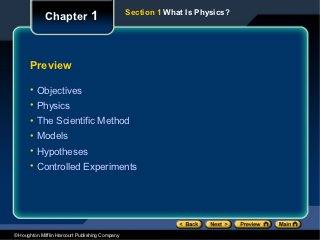
Physic Chapter 1 Lesson 1 What is Physics
- 1. Section 1 What Is Physics? Chapter 1 Preview • Objectives • Physics • The Scientific Method • Models • Hypotheses • Controlled Experiments © Houghton Mifflin Harcourt Publishing Company
- 2. Section 1 What Is Physics? Chapter 1 Objectives • Identify activities and fields that involve the major areas within physics. • Describe the processes of the scientific method. • Describe the role of models and diagrams in physics. © Houghton Mifflin Harcourt Publishing Company
- 3. Section 1 What Is Physics? Chapter 1 The Branches of Physics © Houghton Mifflin Harcourt Publishing Company
- 4. Section 1 What Is Physics? Chapter 1 Physics • The goal of physics is to use a small number of basic concepts, equations, and assumptions to describe the physical world. • These physics principles can then be used to make predictions about a broad range of phenomena. • Physics discoveries often turn out to have unexpected practical applications, and advances in technology can in turn lead to new physics discoveries. © Houghton Mifflin Harcourt Publishing Company
- 5. Section 1 What Is Physics? Chapter 1 Physics and Technology © Houghton Mifflin Harcourt Publishing Company
- 6. Section 1 What Is Physics? Chapter 1 The Scientific Method • There is no single procedure that scientists follow in their work. However, there are certain steps common to all good scientific investigations. • These steps are called the scientific method. © Houghton Mifflin Harcourt Publishing Company
- 7. Section 1 What Is Physics? Chapter 1 Models • Physics uses models that describe phenomena. • A model is a pattern, plan, representation, or description designed to show the structure or workings of an object, system, or concept. • A set of particles or interacting components considered to be a distinct physical entity for the purpose of study is called a system. © Houghton Mifflin Harcourt Publishing Company
- 8. Section 1 What Is Physics? Chapter 1 Hypotheses • Models help scientists develop hypotheses. • A hypothesis is an explanation that is based on prior scientific research or observations and that can be tested. • The process of simplifying and modeling a situation can help you determine the relevant variables and identify a hypothesis for testing. © Houghton Mifflin Harcourt Publishing Company
- 9. Section 1 What Is Physics? Chapter 1 Hypotheses, continued Galileo modeled the behavior of falling objects in order to develop a hypothesis about how objects fall. If heavier objects fell faster than slower ones,would two bricks of different masses tied together fall slower (b) or faster (c) than the heavy brick alone (a)? Because of this contradiction, Galileo hypothesized instead that all objects fall at the same rate, as in (d). © Houghton Mifflin Harcourt Publishing Company
- 10. Now what do you think? What are some topics you expect to study this year in physics? How do scientists discover the laws of physics? Do the laws of physics ever change? © Houghton Mifflin Harcourt Publishing Company
Notes de l'éditeur
- The understanding that science is an evolving field of knowledge rather than a static set of facts can help generate student interest in science. Use the example of Galileo’s hypothesis to initiate a discussion on the scientific method. Scientists develop and test hypotheses to discover new theories or laws, or to modify existing theories. Thus, the set of established physical laws and theories changes over time as hypotheses are tested and revised. See if students can suggest examples of theories or laws that have evolved. Examples you may wish to discuss include the development of atomic theory and the relativity of space and time.
